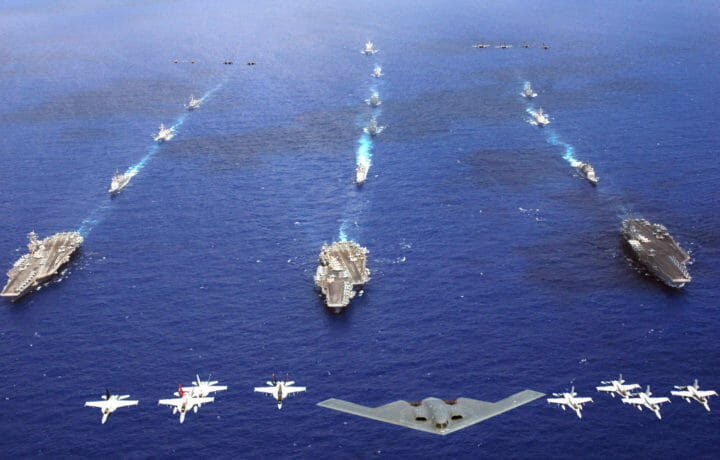During the Second World War, the United States Navy added nearly 1,200 major combatant warships, including 99 aircraft carriers and eight “fast” battleships; as well as even more support and logistic vessels. When the war ended in 1945, the U.S. Navy had 6,768 active ships in the fleet. Shipyards around the country worked around the clock to build that mighty fleet.
Currently, the U.S. Navy is struggling to achieve the 355 manned warships mandated by Congress. At issue is that the United States Navy lacks the facilities to build and maintain its fleet. There are just four “national shipyards” and the capacity within the industrial base remains the biggest barrier to adding more ships.
“We have an industrial capacity that’s limited,” Chief of Naval Operations Adm. Mike Gilday said in August during an event at the Heritage Foundation. “In other words, we can only get so many ships off the production line a year. My goal would be to optimize those production lines for destroyers, for frigates, for amphibious ships, for the light amphibious ships, for supply ships.”
Gilday also noted that two of the U.S. shipyards have made significant infrastructure investments that could set them up to build more ships. Austal USA recently built a new steel line, and could soon construct a second line for the Navy’s Constellation-class frigate program; while HII’s Ingalls Shipbuilding invested nearly $1 billion over the last five years to modernize its Pascagoula, Miss., yard.
“We do need to think carefully about the infrastructure to build the ships,” explained Capt. Robert A. Sanders, JAG Corps, U.S. Navy (Retired), and distinguished lecturer of national security at the University of New Haven.
“If you think about global warfare – such as World War II – we had the capacity to turn out ships on a monthly basis. That is different now, but we also have to understand we don’t need that level of firepower,” Sanders told ClearanceJobs.
The United States Navy won’t ever need thousands of ships, and likely wouldn’t have the sailors to crew them anyway. The vessels of today are smaller and more capable.
“We also don’t need as many, but if you lose one in a future war, it is like losing ten in World War II,” warned Sanders. “So it is important that we have the facilities to replace what we could lose.”
The Great Decline
At issue is that since the 1970s, 14 “defense-related shipyards” have been shuttered, while only one new shipyard has opened. In addition, the number of firms still in the shipbuilding sector has dwindled.
Moreover, the shipbuilding industry is facing an ongoing challenge to attract, train and retain skilled labor. Just as the U.S. military has struggled to fill its ranks, the shipbuilding industry is facing a very serious labor shortage. There are not enough new workers to replace those who are retiring.
A Pentagon report released last year warned that the shipbuilding “industrial base today lacks the resiliency and bench strength to meet required demand,” and it stressed the need for long-term, prioritized workforce investments.
Consolidation Among Smaller Shipyards
The shipbuilding industry could also see consolidation.
Earlier this month, Bollinger Shipyards, the largest privately-owned and operated shipbuilder in the United States, announced that it has entered into an agreement to acquire VT Halter Marine, Inc. and ST Engineering Halter Marine Offshore. The transaction would expand Bollinger’s new construction and repair capacity and capabilities to better serve its key defense and commercial customers.
“For over 75 years, my family has been dedicated to providing our government and commercial customers with the highest levels of quality, support and service in the U.S. shipbuilding industry,” said Ben Bordelon, CEO and President of Bollinger Shipyards, via a statement.
“The addition of VT Halter Marine and STEHMO in Pascagoula, Mississippi is strategic as it further strengthens our position in the industry and U.S. defense industrial base by allowing Bollinger to expand our footprint, capabilities and suite of innovative solutions that we can provide to our customers,” Bordelon added.
According to the company, this acquisition would provide expanded opportunities for Bollinger to better serve and deepen its relationships with its key defense and commercial customers with an increased capacity and footprint, improved efficiencies, enhanced economies of scale, and access to a large skilled workforce, including increased engineering capacity.
Bollinger, which has 14 shipyards in Louisiana, will reportedly gain 378 acres, including two shipyards in Pascagoula, Miss., and two dormant yards north of Pascagoula.
The Infrastructure to Build the Fleet
That consolidation of smaller builders could prove critical to addressing the shortcoming in the defense industrial base. There are many good reasons why more facilities can’t build these vessels.
“Warships hold a lot of secrets and they can’t readily outsource it,” Sanders continued. “It is a national security issue.”
However, these smaller shipyards could hold a key to producing many of the other vessels needed for the U.S. military.
“The Navy doesn’t have just combatants,” explained Sanders.
As noted, during World War II, there may have been 1,200 major combatants, but it built thousands more support ships, and those are vital to protecting America’s interests.
“We’ve seen that Russia is paying close attention to the Arctic, and we’ll need icebreakers,” said Sanders. “Even as our aircraft carriers may be nuclear-powered, they still need fuel for the aircraft onboard, and we will need to increase the number of fuelers.”
The merger of smaller shipyards could increase the efficiency of how they operate.
“Instead of reduced competition, it will make those companies become more efficient,” Sanders suggested. “Instead of doing two things in two different locations, you can both things at one location. This will streamline efforts.”




